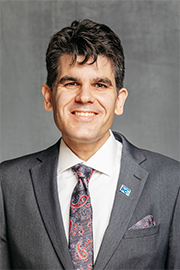- Mar/30/23 9:30:00 a.m.
Yes, 435 over the course of this year reduced hours or closed altogether. Never have we seen emergency room closures to this degree. An emergency room is supposed to be there for you when you’re in an emergency.
So what does this government do? Even when the paramedics have been sounding the alarm—code red, code white—
So what does the government do? Instead of addressing the core issue, which is having the appropriate resources for nurses and having the appropriate staff in hospitals, Bill 124 is compounding that problem, because you cannot recruit into a broken system. You can throw some money at some of those nurses—they’re not going to go back into that workplace because it is an unhealthy workplace and they’re very aware of how unhealthy it is. So what they will do is alleviate the wait-list for the ambulances—so they will give you a hallway nurse. Again, this was a program that the Liberals brought in. The only reason we found out about it at the time is because I was in a hospital with my husband and one of his former students was the hallway nurse. He said, “What are you doing here?” She said, “I’m the hallway nurse.” There’s a separate nursing category. It came out in committee, and the government said, “We didn’t create that position”—but actually, it was a funded line. At least I could track that money, as the finance critic. There are only two recognized parties in this place, and I take my job very seriously. Finding those lines and identifying where those resources are going or not going is obviously really important for us because it’s how we try to hold the government to account.
Anyway, now we’ve got more hallway nurses, but you still haven’t addressed the core issue of why the backlog is happening with the paramedics and the ambulances. But you’re quick to put a Band-Aid on it. It is a flashy little funding announcement—$500 million across the province to address this issue—but you haven’t addressed the issue. You’ve just bought yourself some time, and people are still hurting throughout that process.
In the last quarter, this government also failed to address the $570 million in cash that had been budgeted for health, education, and children’s and social services.
And the education funding in this particular budget is a bit of a shell game, I have to say, because the government has incorporated the federal dollars for the $10-a-day national child care plan. That $2.3 billion that the government says they are investing in schools is not going to elementary schools, it’s not going to secondary schools—it’s parked there because it looks good. Even that $2.3 billion that’s allocated for child care—because child care falls under the Ministry of Education—is not going to get out there too. Do you know why? Because people are not entering the early learning and care sector. They’re not entering that child care sector because it pays so poorly. When the government says, “We value you, but you’re only worth $19 an hour”—to take care of our children in those first five years, no less, when brain development is a key factor, when you’re dealing with two- and three-year-olds who were born into the pandemic and whose language acquisition was seriously compromised by masks, for instance.
I think this is the frustrating piece, overall. The government really has the right language, “biggest budget ever,” but when you follow where the money is going, the money is not getting to the most important places: those pressure points which (1) could make people’s lives better and, (2) could save money down the line—because what we heard at finance committee through the budget consultations is that housing is health care.
This government has—I guess you can call it a housing plan. It comes by way of Bill 23, which we did not support because it takes away the very tools that municipalities need to facilitate housing in Ontario. When AMO says to us, “The cumulative impact of proposed changes to municipal fees and charges is significant and contrary to the widely accepted concept that growth should pay for growth”—I just want to say that these are the 444 municipalities across Ontario, who voice their concerns through their provincial association, which is the Association of Municipalities Ontario. This is what they say: “While AMO would like to support the province’s housing objectives, it cannot support changes that largely place the burden of carrying the costs associated with development onto municipalities. AMO believes that the proposed changes may contradict the goal of building more housing in the long term as it merely shifts the financial burden of growth-related infrastructure onto existing taxpayers.”
So not only do we have a cost-of-living crisis in Ontario, but we have a government that is willing to download the cost of housing to municipalities, which, in turn, is going to increase the taxes of the people in communities. You’re throwing gasoline on the fire. Our critic on housing did such a good job of doing an analysis of the tax increases across the province. Every municipality, with a few exceptions, had to increase their taxes to just carry out their planning, the government’s own objective, of facilitating more housing in Ontario.
When you don’t listen to people, just like the doctor I started my conversation off with—just like doctors were not consulted about downloading of vaccine transfer costs to family physicians. They would have told you, “We only bill the province $3 to $5 for those vaccines. So there are two choices: one, we don’t deliver the vaccines; two, we pass the cost onto the person who is getting the vaccine. Those are the two choices.” However, the government doesn’t know that, because the government didn’t talk to the doctors about downloading of vaccine costs to family physicians—as they didn’t do for AMO, as well.
“Municipalities are attempting to make sense of the government’s response to the housing supply crisis brought about by the COVID-19 demand spike.
“AMO will continue to shine a light on what is wrong with legislative changes that are based on a false premise.”
This is a very painful battle of words between the municipalities, which largely manage municipal housing stock planning, and the government, which has removed rent control, so we have record evictions. They are dead set against building attainable, affordable housing.
We have said to the government that developers are in the business of building homes to make money, and some of those homes, now, are going to be built on the greenbelt. The greenbelt is not where new immigrants are going to be living, I have to tell you. The new immigrants who come into KW want to be close to public transit, grocery stores, schools. None of those things exist out on the greenbelt. Do you know why? Because the greenbelt is sacred. It is environmentally sensitive. It is key to the overall health and well-being of this province. It is something that the Ontario farming association has said, “Listen”—how many acres a day?
- Hear!
- Rabble!
- Mar/30/23 10:40:00 a.m.
The Olde Forge Community Resource Centre in my riding of Ottawa West–Nepean provides crucial supports to seniors and people living with disabilities that allow them to lead healthy, independent lives and stay out of the hospital. They’ve been trying to survive on 2012 funding levels, while demand for services is going up. They begged this government for a budget increase, but to no avail. Now, starting on Monday, 95 seniors and people with disabilities will go without services because of this government’s inaction.
Why is the Premier willing to let such vulnerable people lose such vital supports?
Speaker, it’s not just the Olde Forge; 30 community social service organizations in eastern Ontario are faced with the same challenge and will have to make cuts, thanks to this government’s decisions. Hospital CEOs in eastern Ontario called on the Premier to support these organizations because they know that these organizations keep people out of hospitals, with preventive health care, and help people get home sooner, with Meals on Wheels and home care. Just $7 million would allow these organizations to maintain their service levels.
Will the Premier listen to the hospital CEOs and properly fund these organizations?
- Hear!
- Rabble!
- Mar/30/23 11:10:00 a.m.
My question is to the Premier.
Barbara Savage is 84 years old and lives in London West. She recently received a sudden and shocking diagnosis of stage 4 breast cancer and underwent a double mastectomy in February. With tubes dangling everywhere from her chest, she was discharged and told a nurse would come to her home the next day. Speaker, 11 days later, a nurse finally came. When the tubes filled with blood, Barbara’s daughter had to google how to drain them herself.
Does the Premier believe that this is an acceptable standard of home care?
When Barbara and her daughter frantically called ParaMed, they were told no nurses were available. Thankfully, Barbara did not develop complications, but many patients do, forcing them back into the hospital.
Will this government admit that its failure to address the home care worker shortage, its refusal to drop the unconstitutional Bill 124, is putting the health of Ontarians like Barbara at risk?
- Hear!
- Rabble!
- Mar/30/23 11:10:00 a.m.
Thank you to the member opposite for the question.
No, this is an unacceptable situation. This should not have happened, and I feel very badly for that person who waited 11 days for someone to come and see them.
Our government has made significant investments into home care. A strong home and community care sector is critical to our government’s plan to end hallway health care and build a patient-centred, connected system. That’s why a few years ago—last year, we invested an additional billion dollars to improve the quality of care and keep the people of Ontario in their homes longer with the care that they need.
We like the model at the Southlake hospital, Southlake@home, which has the home care provider meeting with the person who is going to receive the care in the hospital, so they can meet the doctor, the nurse and get the discharge papers, so that person will know that the person will be there and when. We want to make sure that that’s the kind of system we have across Ontario, so people get home care which is appropriate and can stay out of hospital and get well.
As this government has said many times, the only thing better than care close to home is care at home. In partnership with hospitals, primary care and our Ontario Health teams, Ontario is expanding and improving access to home and community care.
Through the 2022 budget, the government announced a plan to invest a billion dollars over three years to get more people connected to care in the comfort of their own home, but our government is now, through this budget, accelerating investments to bring funding in 2023-24 up to $569 million, including nearly $300 million to support contract rate increases to stabilize the home and community care workforce. This funding will also expand home care services and improve the quality of care, making it easier and faster for people to connect to care.
Having strong home and community care for people like Barbara is a key part of this government’s plan for connected and convenient care.
- Hear!
- Rabble!
- Mar/30/23 1:40:00 p.m.
I want to thank the member for his discourse, and I want to say that the citizens of the riding of Essex are very excited, because this budget makes another reference to the regional hospital that’s being constructed that’s going to serve my citizens in the riding of Essex. Also, my colleague from Windsor–Tecumseh here is very excited, along with the citizens in Windsor–Tecumseh, because this budget continues the commitment to build the regional hospital in Windsor–Tecumseh that’s going to serve our whole region.
And so my question to the member is, in addition to this fantastic investment for Essex and Windsor–Tecumseh, what else is in this budget in regard to health care that is going to serve the citizens of the province of Ontario?
- Hear!
- Rabble!
- Mar/30/23 2:30:00 p.m.
Thank you to the member from Don Valley East for your presentation. I know you are a doctor and you understand the health care system very well and the dynamics of the hospital system. You’re asking why we are not hiring foreign-trained doctors in the system.
Actually, we are hiring 50 more foreign-trained doctors into the system, and we allocated a huge chunk of money in this budget. Also, our plan to both build the new hospital and expand the existing one—it’s a plan to build a brand new hospital serving Mississauga and Brampton, a plan to redevelop St. Mary’s General and Grand River Hospital in Kitchener-Waterloo, plan to build a new hospital in Uxbridge and one in Windsor.
We are doing huge investments through this budget. I will ask the member, don’t you think these are huge investments in the health care system?
- Hear!
- Rabble!
- Mar/30/23 3:30:00 p.m.
I want to thank the member for Parkdale–High Park for her question. Every week, when I come in to Queen’s Park, I pass by her riding. I go by St. Joseph’s hospital. I understand that a significant redevelopment is happening at St. Joseph’s. I know back home, Hôtel-Dieu Grace and Windsor Regional, both CEOs have given me very supportive statements about this budget, indicating how much they appreciate the support being given to those particular hospitals as part of this budget.
My question for the member is, for St. Joseph’s, is there good news that this government has provided for that redevelopment? If you can share with the assembly what that might be.
- Hear!
- Rabble!
- Mar/30/23 4:00:00 p.m.
I’ll ask my question to the member from Oakville North–Burlington. Thank you for your remarks today. On this side of the House, we are deeply, deeply concerned about the privatization of our health care services. We know that private, for-profit care costs more. A knee surgery in a public, not-for-profit hospital costs about $10,000. It’s somewhere between $20,000 and $28,000 in a private, for-profit clinic. The Auditor General reports that we’ve got excess surgical spaces in our public, not-for-profit hospitals. Why isn’t your government using those? Why don’t you repeal Bill 124 so that we get more nurses and health care workers on the job? Why is your government creating a crisis in our public health care system, only to turn it over to private for-profit, where we’ll be paying much, much more?
- Hear!
- Rabble!









